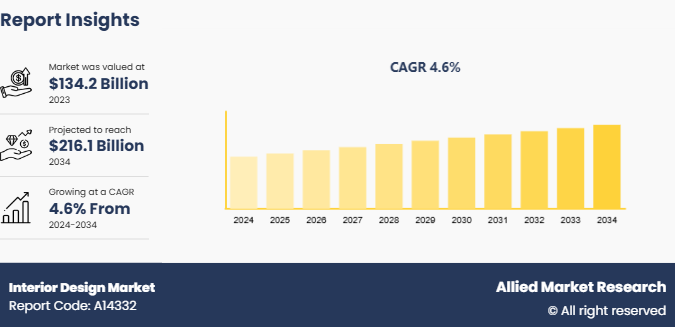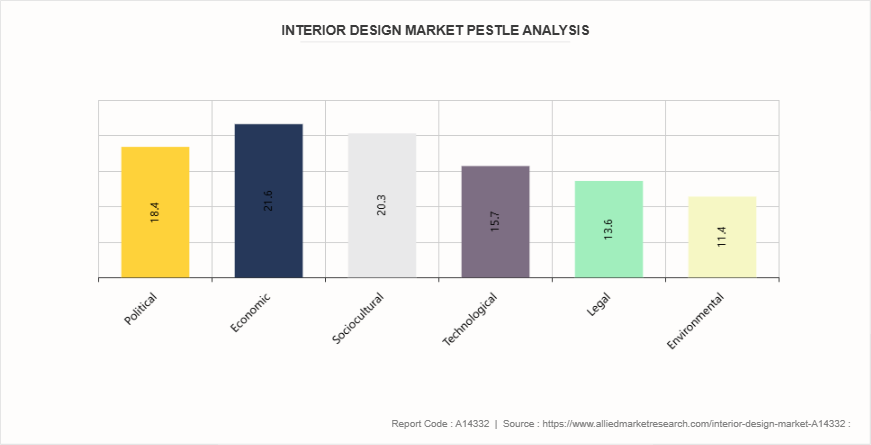Interior Design Market Research, 2034
The global interior design market size was valued at $134.2 billion in 2023, and is projected to reach $216.1 billion by 2034, growing at a CAGR of 4.6% from 2024 to 2034. Interior design is the art and practice of planning and creating functional, aesthetically pleasing indoor spaces. It involves selecting and arranging furniture, color schemes, lighting, textures, and materials to improve the visual attraction and functionality of space.
Interior designers consider factors such as spatial layout, human interaction, and the purpose of space while creating environments that align with the needs of client and style preferences. Interior designers combine creative vision with technical knowledge to balance form and function, ensuring that spaces are visually beautiful along with being practical and comfortable.
Interior design can range from residential, commercial, to public spaces, with professionals often working on projects such as homes, offices, retail stores, and hospitality venues. Effective interior design transforms ordinary spaces into unique, inspiring environments tailored to specific purposes and preferences of consumers.
Key Takeaways
The interior design market study covers 20 countries. The research includes a segment analysis of each country in terms of value ($Billion) for the projected period 2024-2034.
More than 1, 500 product literatures, industry releases, annual reports, and other such documents of major interior design industry participants along with authentic industry journals, trade associations' releases, and government websites have been reviewed for generating high-value industry insights.
The study integrated high-quality data, professional opinions and analysis, and critical independent perspectives. The research approach is intended to provide a balanced view of global markets and to assist stakeholders in making educated decisions in order to achieve their most ambitious growth objectives.
Key Market Dynamics
Urbanization and the rise in the number of residential construction projects have increased demand in the global interior design market by creating a need for aesthetically appealing and functional living spaces. Rapid urban development has led to a surge in housing projects, apartments, and high-rise complexes, particularly in emerging economies, where populations are shifting toward cities for better opportunities.
Interior designers are increasingly seeking to optimize space utilization in compact urban dwellings, by mixing functionality with visual appeal. Developers often collaborate with interior designers to improve the marketability of properties by incorporating modern design trends and technology-driven solutions.
Furthermore, rise in preference for sustainable and eco-friendly interiors aligns with urban housing initiatives that focus on green building practices. As more urban households seek tailored designs that reflect individual lifestyles and meet contemporary standards, the interior design market share benefits from consistent and growing demand driven by urban and residential expansion.
However, a limited skilled workforce for advanced design software restrains the global interior design market revenue by slowing project execution and innovation. Modern interior design increasingly relies on advanced software such as 3D modeling, virtual reality, and AI-based tools to create precise, customized designs and immersive client presentations. Whereas a shortage of proficient professionals in these technologies reduces efficiency and restricts the adoption of cutting-edge solutions in interior home design.
Firms face challenges in meeting client expectations for quick turnarounds and tech-integrated designs, impacting their competitiveness. In addition, training existing staff to gain expertise in these tools requires considerable time and investment, further delaying project timelines. In regions where technological expertise is scarce, businesses may struggle to expand their offerings or enter new markets, limiting the overall growth potential of the interior design industry.
The emergence of 3D printing for bespoke furniture and decor has created numerous opportunities in the global interior design market growth by enabling highly customized and intricate designs tailored to individual client preferences. Interior designers are utilizing 3D printing technology to produce unique furniture pieces and decorative elements with precision and efficiency.
3D technology allows for the creation of complex geometries and innovative materials while minimizing production waste, which aligns with the increasing demand for eco-friendly solutions. The ability to produce prototypes at a lower cost facilitates faster design modifications, leading to improved client satisfaction.
Moreover, collaborations between designers and manufacturers are driving the development of exclusive product collections that cater to specialized customer needs. By offering greater creative flexibility and cost-effective production, 3D printing is expanding growth prospects within the interior design market.
PESTLE Analysis of Global Interior Design Market

Political: Government regulations on construction, zoning laws, and sustainability standards influence interior design projects. Policies promoting green building and energy efficiency also impact design choices.
- Economic: Economic growth increases disposable income, driving demand for residential and commercial interior design. Recessionary periods, however, may reduce spending on luxury design services and home renovations.
- Sociocultural: Changing consumer preferences for personalized, functional, and sustainable interiors are reshaping the interior design market. The rise in demand for wellness-focused designs and eco-conscious living influences design trends in recent years.
- Technological: Advancements in 3D printing, virtual reality, and smart home technologies are transforming the market. These technologies allow for more innovative, efficient, and customized designs.
- Legal: Intellectual property laws, safety regulations, and labor standards affect design practices. Compliance with building codes and environmental regulations is crucial for interior design projects.
- Environmental: Increased focus on sustainability drives demand for eco-friendly materials and energy-efficient designs. The increased demand for reducing waste and incorporating green design principles is growing in popularity, thus influencing interior design market trends.
Market Segmentation
The interior design market is segmented by type, price, end user, and region. By type, the market is classified into newly decorated and repeated decorated. By price, it is bifurcated into economy and luxury. By end user, the market is divided into commercial and residential. Region wise, the market is analyzed across North America, Europe, Asia-Pacific, and LAMEA.
Regional/Country Market Outlook
Increase in urbanization, construction activities, and demand for customized, high-end interiors has made North America the leading region in the market. The region has experienced significant investment in home renovations, luxury furniture, and professional interior design services. The growth in integration of smart home technologies, such as IoT-enabled lighting and climate control systems, is further fueling market demand for interior design among consumers.
In addition, a rising focus on sustainable designs using eco-friendly materials and energy-efficient solutions also contributes to growth. Moreover, real estate development, especially in urban areas, and the increase in popularity of wellness-focused spaces, including biophilic design, are driving interior design market expansion. The presence of global design firms and widespread use of advanced technologies has further strengthened the market share of North America in the interior design market.
Increase in urbanization and rising disposable incomes in the Asia-Pacific region are creating significant growth opportunities for the market. As more people move to urban areas, demand for residential and commercial spaces, along with professional design services, is anticipated to increase rapidly. The growing middle class is seeking personalized and high-quality interiors, driving the market for luxury and customized designs.
Sustainability trends are gaining momentum, with eco-friendly materials and energy-efficient solutions becoming a priority for consumers. Furthermore, the increase in adoption of smart home technologies offers opportunities for integrating IoT and automation into interior designs, expanding opportunities during the interior design market forecast period.
Industry Trends:
Circular design principles are influencing the market by promoting the use of recycled materials and adaptable furniture with extended lifespans. Designers are focusing on creating interiors where components can be disassembled, repaired, or repurposed, reducing waste and supporting sustainability goals. For instance, the Buy Back & Resell program of IKEA encourages customers to return used furniture, which is then refurbished and resold, minimizing waste and extending product lifecycles.
Similarly, Herman Miller incorporates recycled materials into its iconic furniture designs, such as the Aeron chair, crafted using ocean-bound plastics. These initiatives demonstrate how companies are actively aligning with circular design concepts, catering to environmentally conscious consumers, and promoting sustainable practices within the market.
In addition, modular furniture designs are gaining traction, allowing clients to reconfigure pieces to meet changing needs. Software tools are being utilized to assess material efficiency and environmental impact during the design phase. The increase in adoption of such practices reflects growing consumer interest in ethical and sustainable interiors, driving the popularity of circular design in the industry.
Competitive Landscape
The major players operating in the market include Gensler, Perkins and Will, Inc., HOK Group, Inc., AECOM Technology Corporation, Shawmut Design and Construction, Inc., Hirsch Bedner Associates, LLC, Foster and Partners LLP, IA Interior Architects, Inc., Wilson Associates, Inc., and Rockwell Group, LLC.
Recent Key Strategies and Developments
In May 2022, Havenly expanded its digital services by launching in-person interior design visits for designers to take measurements and create virtual designs for clients.
In March 2022, Modsy introduced a virtual remodeling service using 3D technology, allowing customers to visualize and explore redesigns virtually.
Key Benefits For Stakeholders
This report provides a quantitative analysis of the market segments, current trends, estimations, and dynamics of the interior design market analysis from 2024 to 2034 to identify the prevailing interior design market opportunities.
The market research is offered along with information related to key drivers, restraints, and opportunities.
Porter's five forces analysis highlights the potency of buyers and suppliers to enable stakeholders make profit-oriented business decisions and strengthen their supplier-buyer network.
In-depth analysis of the interior design market segmentation assists to determine the prevailing market opportunities.
Major countries in each region are mapped according to their revenue contribution to the global market.
Market player positioning facilitates benchmarking and provides a clear understanding of the present position of the market players.
The report includes the analysis of the regional as well as global market trends,key players, market segments, application areas, and market growth strategies.
Interior Design Market Report Highlights
| Aspects | Details |
| Market Size By 2034 | USD 216.1 Billion |
| Growth Rate | CAGR of 4.6% |
| Forecast period | 2024 - 2034 |
| Report Pages | 243 |
| By Type |
|
| By Price |
|
| By End User |
|
| By Region |
|
| Key Market Players | Shawmut Design and Construction, Inc., HOK Group, Inc., Rockwell Group, LLC, IA Interior Architects, Inc., Wilson Associates, Inc., Hirsch Bedner Associates, LLC, Foster and Partners LLP, Gensler, AECOM Technology Corporation, Perkins and Will, Inc. |
Upcoming trends in the global interior design market include sustainability, smart home integration, biophilic design, minimalism, and personalized spaces.
The leading application of the interior design market is commercial design for offices, hotels, and retail spaces.
Based on region, North America held the highest market share in terms of revenue in 2023.
The global interior design market was valued at $134.2 billion in 2023.
The major players operating in the interior design market include Gensler, Perkins and Will, Inc., HOK Group, Inc., AECOM Technology Corporation, Shawmut Design and Construction, Inc., Hirsch Bedner Associates, LLC, Foster and Partners LLP, IA Interior Architects, Inc., Wilson Associates, Inc., and Rockwell Group, LLC.
Loading Table Of Content...


